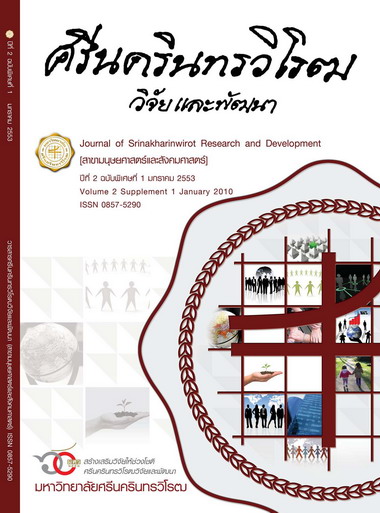ดนตรีในพิธีกรรมแซปางของชาวไทดำ (TAI DAM MUSIC IN THE SAEPANG CEREMONY)
Keywords:
Ethnic Music, Sae Pang Ceremony, Tai DamAbstract
บทคัดย่อ การศึกษาเรื่องดนตรีในพิธีกรรมแซปาง (พิธีกรรมการไหว้ครูหมอมด) ของชาวไทดำ ที่บ้านนาป่าหนาด อำเภอเชียงคาน จังหวัดเลย มีวัตถุประสงค์เพื่อศึกษาเกี่ยวกับการสืบทอด การปรับเปลี่ยนของพิธีกรรม และดนตรีที่ใช้ในการแซปาง เป็นการวิจัยเชิงคุณภาพทางดนตรีชาติพันธุ์วิทยา โดยการศึกษาเอกสารภาคสนาม งานภาคสนามได้จากการสัมภาษณ์และการสังเกตจากผู้มีส่วนร่วมในการประกอบพิธีกรรม คือ ประธานในพิธี ผู้เข้าร่วมพิธีและบุคคลทั่วไป ผลการศึกษาพบว่า พิธีกรรมแซปางของชาวไทดำที่บ้านนาป่าหนาดนี้ไม่มีการสืบทอดแต่อย่างใด หมอมดในปัจจุบันคือนายประสิทธิ์ แห่วกุยอม ซึ่งเป็นผู้ได้รับมอบให้เป็นประธานในการทำพิธีจากครูรุ่นก่อน ไม่ได้จัดทำพิธีแซปางนี้แก่คนรุ่นหลังอีก และไม่ได้ถ่ายโอนตำแหน่งประธานพิธีนี้แก่ผู้ใด เนื่องจากคนส่วนมากไปรักษา การเจ็บป่วยจากแพทย์แผนปัจจุบัน คงพบเฉพาะการแซปาง (ฟ้อนรำ) ซึ่งประยุกต์มาจากการแซของหมอมดในพิธีกรรมแซปาง โดยมีท่าฟ้อนรำ 4 ท่า คือ ท่าแซอิ้น ท่าแซตอกกล้วยเสี้ยน ท่าแซซ่า และท่าแซต่าว เครื่องดนตรีที่ใช้ในการแซปางได้แก่ ผางฮาดซึ่งเป็นฆ้องที่ไม่มีปุ่ม จัดอยู่ในประเภทเครื่องตีมีจำนวน 1 ใบ ผู้ตี 1 คน และบั้งบู ซึ่งเป็นกระบอกไม้ไผ่สำหรับกระทุ้งเป็นจังหวะ จำนวน 8 บั้ง และมีผู้กระทุ้งบั้งละ 1 คน จังหวะดนตรีที่ใช้ประกอบการแซปางนั้นแบ่งออกเป็น 5 แบบ แบบที่ 1 ใช้ประกอบท่าเดินรอบบริเวณต้นปาง แบบที่ 2 ใช้ประกอบการแซท่าแซอิ้น แบบที่ 3 ใช้ประกอบการแซท่าแซตอกกล้วยเสี้ยน แบบที่ 4 ใช้ประกอบการแซท่าแซส่าและแซต่าว แบบที่ 5 เป็นการบรรเลงเวลาเปลี่ยนท่าเพื่อบอกผู้แสดงให้เกิดความพร้อมเพรียงในการเปลี่ยนท่า
Abstract
This study, entitled Music in Sae Pang Ceremony (Paying Homage to Shaman Teacher) of Tai Dam at Ban Na Pa Nat, Amphoe Chiang Khan, Loei Province, aimed 1) to explore the transmission and change of the ceremony; 2) To examine the music accompanying the Sae Pang. Qualitative ethnomusicological research methodology was used; data were collected from written documents and fieldwork materials. Fieldwork data were gathered through interviewing and observing the persons involved---chief of the ceremony, participants, and general public. The results of the study revealed that the Sae Pang Ceremony at Ban Na Pa Nat, according to Mr.prasit Weikuyom, the ceremony chief, was no longer transmitted to younger generation, because the people of new generation turn to modern medical treatment rather than the traditional way of Sae Pang. Only Sae Pang dances which were derived from the dance of mo mot Shaman in Sae Pang Ceremony were survived. The Sae Pang dance consisted of 4 postures or movements: Sae In, Sae Tok Khluai Sain, Sae Sa, and Sae Tao. There were 2 musical instruments used for accompanying the Sae Pang dance---the Phang Hat, a flatted bronze gong, a type of percussion with one player; 8 bang bu, bamboo tubes for rhythmic stamping with one player each. The musical rhythmic patterns were classified into 5 types: firstly, for walking around a Pang tree; secondly, for the Sae In dance; thirdly, for Sae Tok Khluai Sian dance; fourthly, for the Sae Tao; and fifthly, for the rhythmic pattern to signal the dancers for movement change.
Downloads
Downloads
Published
How to Cite
Issue
Section
License
Srinakharinwirot Research and Development Journal of Humanities and Social Sciences is licensed Under a Creative Commons Attribution-NonCommercial-NoDerivs 4.0 International (CC-BY-NC-ND 4.0) License, Unless Otherwise Stated. Please Read Journal Policies Page for More Information on Open Access, Copyright and Permissions.



